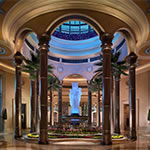At Las Vegas Sands Corp. properties—including at the Palazzo and Venetian resorts in Las Vegas—sustainability and green practices are more than state of the art. They are constantly upgraded, innovative, and wholly invisible to guests and visitors. “The technology of sustainability has progressed so much that we don’t need to compromise luxury,” says Katarina Tesarova, Sands’ vice president of sustainability.
Initially, like many other organizations, the focus at Sands hotels tended toward conservation. As awareness of green issues grew and environmental practices evolved, however, Sands incorporated a more holistic approach to sustainability—particularly in the design and development of new properties. The Palazzo, which was completed in 2008, is one of the largest LEED-certified buildings in the world, and as the company renovates, updates, and remodels existing properties, it prioritizes improved efficiencies. More than 200 such projects are implemented across its portfolio of international properties each year.

Sands’ sustainability efforts include renewable energy generation through a substantial solar array, upgrades to mechanical equipment, and LED lighting within its various resorts.
A Light Bulb Moment
Sands is a proactive partner in innovation. The property owner worked directly with GE to develop a new generation of LED bulbs for the Palazzo. “We kept telling them we need something with more ‘sparkle,’” Tesarova says with a laugh. “The engineers, looking at the problem in a very technical way, asked us, ‘How you do specify ‘sparkle,’ exactly?”
What the Palazzo’s team sought was a light that would accentuate the hotel interior’s high-end wallpapers, stone finishes, and enormous crystal chandeliers. Standard LED bulbs were not good enough. After numerous iterations and prototypes, GE developed a low-glare bulb that enriched the warm, gold hues of the Palazzo’s décor. The endeavor proved so successful that the new LED bulb will become part of GE’s line available to consumers in retail outlets.
Food Waste for Feedstock
At Sands, there is a heavy focus on recycling. The company has achieved a diversion rate of more than 60 percent, a remarkable achievement for a hotel group. A large portion of that is food waste, uncontaminated portions of which are delivered to pig farms as feedstock. In Macau, China, biodigesters are being tested because food-recycling infrastructure does not exist.

“Because of the size and complexity of integrated resorts, the benefits of sustainability initiatives are really significant,” according to Katarina Tesarova, Sands’ executive director of sustainability.
Pursuing additional sustainability goals, Sands is constantly evaluating and implementing new technologies in the kitchens of the Palazzo and Venetian’s restaurants, three of which are certified by the Green Restaurant Association. Variable-frequency drives for hood fans are being tested, as are new equipment that would improve the efficiency of large walk-in refrigerators and new methods of reducing water and energy usage.
Even the food represents Sands’ commitment. Menus that feature significant sustainable offerings have proven to be especially attractive to meeting and convention planners.
Solving a Water Problem
Although Las Vegas is in the Mojave Desert, its water table is remarkably high. In response, Sands developed a filtration system that is completely unique. The foundations of the Palazzo and Venetian hotels, which include the parking garages, would be submerged if water were not continuously pumped out. That water would normally be released into a storm drain, but Sands stores and treats that low-grade water and uses it for irrigation. This allows the Palazzo to be virtually off of the public water grid for irrigation purposes; no municipal potable water is used for irrigation of the properties’ landscaping.
Fast Track to Sustainability
Tesarova’s career in sustainability has been somewhat circuitous. With a background in law and finance, she was charged with the development of a LEED-certification strategy for a multibuilding project while a senior financial analyst with MGM Resorts International. It was “very large scale and high profile,” Tesarova says. “It was a fast-track project with a steep learning curve. I was roped into sustainability.”
Learn she did, and she hasn’t looked back. “Because of the size and complexity of integrated resorts, the benefits of sustainability initiatives are really significant,” Tesarova says, “and that’s made for a really meaningful career for me. This field is constantly evolving, with new technologies coming out and changes in customer behavior and expectations that keep you on your toes all the time. And then you add the cultural differences and vast variety of infrastructures in the countries in which we operate, and you end up with an intriguing, interesting, and challenging mission.”

